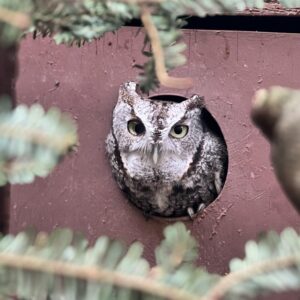8 Fascinating Facts About Owls
February 17, 2025
Posted by Lake Erie Nature and Science Center

Did you know? Eight different species of owls reside in Northeast Ohio throughout the year. Three of the most common include the Great Horned Owl, the Barred Owl and the Eastern Screech-Owl. You can also find them on exhibit at Lake Erie Nature & Science Center in Bay Village, OH. Ahead of the Nature Center’s annual Owl Prowl on Feb. 21, here are some facts about these fascinating creatures.
1. Owls are birds of prey
Birds of prey, also known as raptors, have sharp talons, hooked beaks, and powerful eyesight. These characteristics allow them to maintain a carnivorous diet. Other birds of prey include eagles, hawks, and falcons.
2. Owls are skilled hunters
Owls are covered in extremely soft feathers that provide insulation during cold temperatures. Their feathers allow for silent flight and the ability to strike quietly in pursuit of prey, which include animals several times heavier than themselves.
3. Owls often swallow their prey whole
Owls swallow their prey whole or in large pieces, but cannot digest fur, teeth, bones, or feathers. These pieces are regurgitated, typically once a day, in the form of a pellet.
4. Their eyes are not true “eyeballs”
Owls have large, tube-shaped eyes that are completely immobile. Their retinas contain many rod cells for excellent night vision and depth perception for hunting.
5. Male and female owls are similar in appearance
Birds of prey of the same species often look identical regardless of being male or female. In many species of birds, the male is more colorful than the female (cardinals, for example). The key difference between male and female owls is that females are typically larger than their male counterparts.
6. Owls can rotate their necks 270 degrees
While it is a common misconception that owls can rotate their heads 360 degrees, they are capable of turning their heads 270 degrees in either direction. This flexibility allows them to look around since their eyes are fixed in their sockets.
7. Many owls have asymmetrical ears
Some species of owls have one ear opening higher than the other. This unique adaptation allows the owl to determine what height and direction a sound is coming from.
8. Not all owls hoot
Great Horned Owls and Barred Owls are vocal birds that make the traditional hooting sounds you may already associate with owls. Despite their name, Eastern Screech-Owls do not screech but make sounds of whinnies and soft trills.
Join Lake Erie Nature & Science Center for Owl Prowl on Friday, Feb. 21 at 6 p.m. Enjoy up close encounters with resident owls, experience nocturnal sights and sounds in the planetarium, follow clues to solve the mystery word on an owl scavenger hunt, and head outdoors on a hike in hopes of spotting or hearing wild owls in the surrounding forest. Tickets: $15/person. Tickets are available at www.lensc.org/family-programs. 28728 Wolf Road, Bay Village, OH 44140.
Sources: Lake Erie Nature & Science Center, Cornell University, and National Audubon Society.

